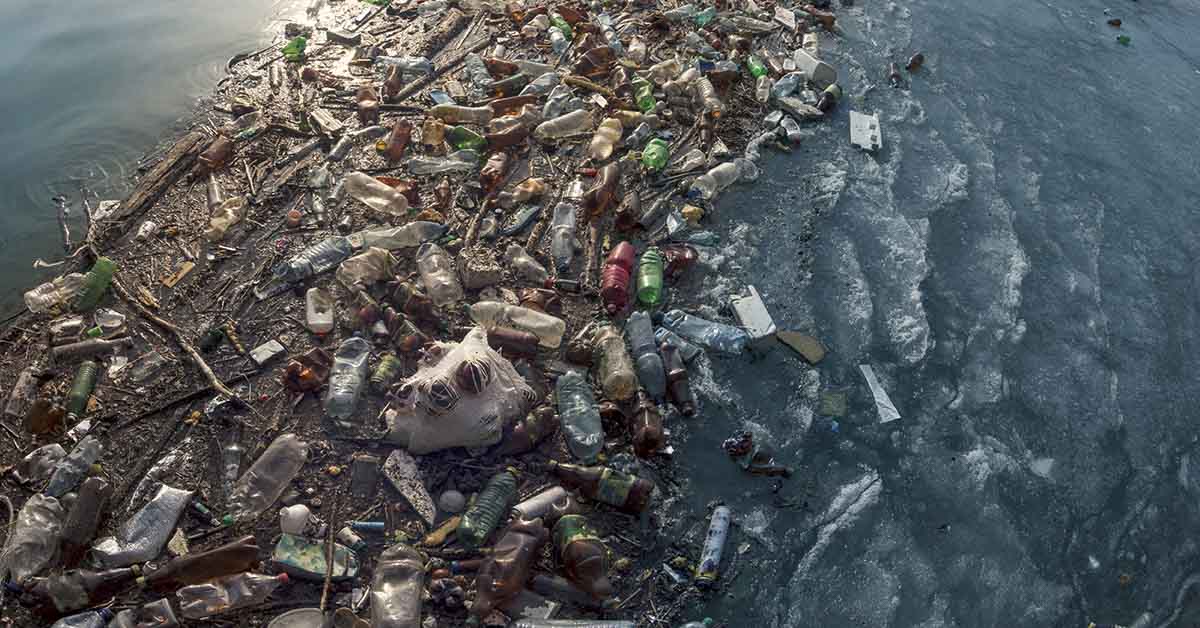In the world’s oceans, there are five offshore plastic accumulation zones. The largest of those is called the North Pacific Garbage Patch and is located halfway between Hawaii and California. Though its location might cause you to assume that the largest contributor would be the United States, specifically the West Coast. New research, however, shows that this is not the case.
90% Of The Garbage in the North Pacific Garbage Patch is From These 6 Countries
The Ocean Cleanup project estimates that 1.15 to 2.41 million tons of plastic enter the ocean each year. It first goes into rivers and other waterways and then works its way into the ocean. More than half of this is less dense than water, so it just floats on the surface. The plastic travels via currents and then accumulates in five different accumulation zones. The biggest of these is the North Pacific Garbage Patch. (1)
The North Pacific Garbage Patch is roughly 1.6 million square kilometers, making it twice the size of Texas and three times the size of France. As already mentioned, it is located approximately midway between Hawaii and California. The patch weighs an estimated 80,000 tons and includes more than 1.8 trillion pieces of plastic. This weight is equal to more than 500 jumbo jets. This also means that there are about 250 pieces of plastic per person on Earth.
Read: Student Creates Plastic Made From Orange Waste That Biodegrades In 90 Days
So Where Is It All Coming From?
Recently a team of researchers from both the Ocean Cleanup Project and Wageningen University in the Netherlands decided to study the garbage in the patch to understand better where it is coming from. While about a third of the trash was unidentifiable, the rest was. Of the identifiable trash, the researchers found that the trash came primarily from six countries, all of which have industrialized fishing industries. (2)
The researchers collected, sorted, and studied 6,000 pieces of trash from the patch. They looked for words printed on the various pieces. Clues to where it came from were things such as language, symbols, and logos. Of the trash that they collected, 26% was fishing related and 3% was plastic buoys and floats.
They identified the origin of 232 of the pieces that they collected. The breakdown by country is as follows:
- 33.6% from Japan
- 32.3% from China
- 9.9% from South Korea
- 6.5% from the United States
- 5.6% from Taiwan
- 4.7% from Canada
Altogether, these six countries made up 92% of the identifiable trash found in the patch. The trash was 10 times more likely to come from fishing activities. This makes sense, as these top six countries regularly are involved in massive fishing operations.
The North Pacific Garbage Patch is Highly Problematic
As we already know, plastics take hundreds of years, if not more, to break down. They last for a long time in the ocean and slowly but surely break apart into smaller and smaller pieces. They eventually turn into microplastics. Microplastics are dangerous for everyone – our ocean ecosystems and the plants and animals in them, as well as human health.
Ocean animals often mistake microplastics for food or unwittingly consume or absorb them while swimming. Also plastic rings and fishing nets can be death traps for many ocean wildlife. The same fish that consume those plastics, which contain toxins that are damaging to human and animal health, end up in our food systems. Eventually you, as a consumer, ingest those toxins.
The Ocean Cleanup Project, as well as other ocean protection groups, have gone on several missions to clean up the North Pacific Garbage Patch, as well as the other four patches around the world. This is difficult, grueling, and slow work. This is especially considering that daily the human population contributes more and more plastics into the environment that eventually end up in the ocean. In order to help, you can do your best to reduce the amount of plastics that you use in your daily life. You can also donate to groups like the Ocean Cleanup Project to help them on their mission to clean up our oceans.
Keep Reading: A half-mile installation just took 20,000 pounds of plastic out of the Pacific — proof that ocean garbage can be cleaned
Sources
- “THE GREAT PACIFIC GARBAGE PATCH.” The Ocean Clean Up
- “More than 90% of identifiable trash in North Pacific Garbage Patch comes from just six countries.” Phys. Bob Yirka. September 2, 2022.
- “Industrialised fishing nations largely contribute to floating plastic pollution in the North Pacific subtropical gyre.” Scientific Reports. September 1, 2022.

